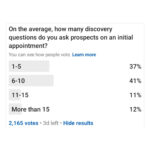Sometimes, the key to success in selling is to get back to basics. I’ve talked a lot in the last few years about how the balance of power has shifted firmly towards empowered buyers. With more information at their fingertips than ever before, customers can research products, compare prices, and make informed decisions without relying heavily on salespeople. This has led some salespeople to become hesitant about taking an active role in guiding buyers through their Buyer’s Journey.
In fact, I’ll be frank. I worry that I’ve dissuaded some salespeople from remembering an essential truth of selling. If you don’t ask for what you want, you won’t get it. To not ask your empowered buyers to buy – or help them advance through their journey – is to abdicate your responsibility as a salesperson.
Don’t make this mistake. Even as buyers have become more empowered, your job is still crucial – to your company and to your buyers. Buyers may have more information, but that information can also be overwhelming – and in many cases, inaccurate or a bad fit for their situation. A skilled salesperson (and you are one of those, right?) who takes charge can cut through the clutter, ask the right questions, and help the buyer arrive at the best solution for their needs.
The key is that you have to be assertive without being pushy. Buyers don’t mind assertive salespeople – but pushy salespeople get eliminated from the Buyer’s Journey. You have to recognize that the buyer is in the driver’s seat, but you must also understand that the buyer often welcomes guidance. By actively participating in the buyer’s journey, the salesperson can help the customer navigate the process more efficiently and come to a decision with confidence. Your buyers will find themselves thinking (or saying) “so, where do we go from here?” quite a bit. Be prepared to guide them.
Here are some ways salespeople can reassert themselves in the sales process:
- Ask thoughtful questions. Dig deep to really understand the customer’s needs, challenges, and goals. Don’t just go through a surface-level qualification checklist. Uncover the underlying issues the buyer is trying to solve. I’ve said for many years that 80% of your chance to win the sale is through your questioning, and that hasn’t changed.
- Provide valuable insights. Use your industry expertise to share perspectives the buyer may not have considered. Offer creative solutions they hadn’t thought of. Position yourself as a knowledgeable partner, not just a vendor. And don’t be afraid to provide expertise, even when it’s not directly tied to a sale. Salespeople today must earn their spot in front of the buyer, and you do that by making the buyer a little better and more knowledgeable during every sales interaction. Salespeople are the world’s best collectors of industry best practices – and some of the worst at sharing them. Break that pattern.
- Journeys need a guide. Don’t be afraid to take charge of the sales cycle. Suggest next steps, schedule follow-up meetings, and keep the buyer on track. This shows you’re invested in their success, not just making a quick sale.
- Address objections head-on. When the buyer raises concerns, don’t dodge them. Acknowledge their doubts, then provide reassurance and evidence to overcome them. Demonstrate you’re listening and want to alleviate their fears.
- Close confidently and directly. Don’t be afraid to ask for the business. If you’ve done the work to truly understand the buyer’s needs, you should be able to make a compelling case for why your solution is the right fit. End the sale decisively, not tentatively.
The most successful salespeople today don’t just react to the buyer’s lead – they proactively shape the sales conversation and Buyer’s Journey. They recognize that even the most informed, empowered buyer still values the salesperson’s expertise and guidance. By reasserting themselves as sources of expertise, these salespeople are able to navigate the buyer’s journey and close deals with confidence.
Of course, this assertiveness must be balanced with genuine curiosity and a customer-centric approach. The goal isn’t to strong-arm the buyer, but to collaborate with them in a way that meets their needs. If you can strike this balance, you will thrive in the new era of buyer empowerment.


 Are you asking enough questions? A couple of weeks ago, I ran a poll on a very popular LinkedIn group. The poll question was simple: “On the average, how many discovery questions do you ask a new customer on an initial appointment?” If you’ve read any of my work at all, you know that I believe that the root of good things in selling is asking a lot of good questions; in fact, questioning is the longest unit in
Are you asking enough questions? A couple of weeks ago, I ran a poll on a very popular LinkedIn group. The poll question was simple: “On the average, how many discovery questions do you ask a new customer on an initial appointment?” If you’ve read any of my work at all, you know that I believe that the root of good things in selling is asking a lot of good questions; in fact, questioning is the longest unit in